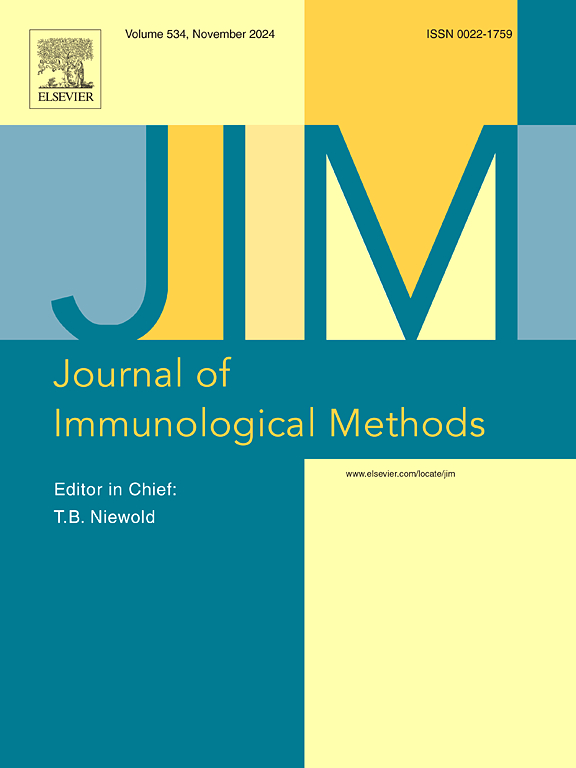从冷冻脐带血中分离单核细胞的高效策略。
IF 1.6
4区 医学
Q4 BIOCHEMICAL RESEARCH METHODS
引用次数: 0
摘要
背景目的:脐带血单核细胞(CBMCs)由脐带血中的各种单核细胞组成,主要包括单核细胞和淋巴细胞。它们还包括较小比例的其他细胞类型,如造血干细胞和祖细胞(HSPCs)以及间充质基质细胞(MSCs)。CBMC 对于获得造血干细胞和祖细胞、间充质干细胞和其他免疫细胞(如自然杀伤细胞)至关重要。这些细胞对支持后续研究和临床应用至关重要。虽然用于 CBMC 富集的自动化设备前景看好,但这些设备的高成本和一次性耗材的费用限制了它们的常规使用。此外,关于从低温保存的脐带血中分离 CBMC 的人工策略的信息也很有限。因此,我们旨在优化稀释缓冲液并改进 CBMCs 的分离程序:方法:我们使用优化的稀释缓冲液和改进的分离程序,提高了从冷冻保存的脐带血中分离出 CBMC 的回收率:结果:CBMCs 和 CD34+ 细胞的平均回收率分别为 42.4% 和 54.3%。值得注意的是,分离过程中使用的所有试剂均为 GMP 级或药物制剂,这表明我们的策略具有潜在的临床效益:讨论:我们设计了一种适用于常规研究和临床应用的优化方案,利用优化的稀释缓冲液和改进的分离程序,从低温保存的脐带血单位中提高 CBMCs 的回收率。本文章由计算机程序翻译,如有差异,请以英文原文为准。
Highly effective strategy for isolation of mononuclear cells from frozen cord blood
Background aims
Cord blood mononuclear cells (CBMCs) comprise a variety of single-nucleated cells found in the cord blood, mainly consisting of monocytes and lymphocytes. They also include a smaller proportion of other cell types, such as hematopoietic stem and progenitor cells (HSPCs) and mesenchymal stromal cells (MSCs). CBMCs are vital for acquiring HSPCs, MSCs, and other immune cells, like natural killer cells. These cells are essential for supporting subsequent research and clinical applications. Although automated equipment for CBMC enrichment has shown promise, the high cost of these machines and the expense of disposable consumables limit their routine use. Furthermore, limited information is available on manual strategies for isolating CBMCs from cryopreserved cord blood. Therefore, we aimed to optimize the dilution buffer and refine the isolation procedure for CBMCs.
Methods
We enhanced the CBMC recovery rate from cryopreserved cord blood using an optimized dilution buffer and a modified isolation procedure.
Results
We achieved average recovery rates of 42.4 % and 54.3 % for CBMCs and CD34+ cells, respectively. Notably, all reagents used in the isolation procedure were of GMP-grade or pharmaceutical preparations, underscoring the potential clinical benefits of our strategy.
Discussion
We devised an optimized protocol suitable for routine research and clinical applications for enhanced recovery of CBMCs from cryopreserved cord blood units using an optimized dilution buffer and a modified isolation procedure.
求助全文
通过发布文献求助,成功后即可免费获取论文全文。
去求助
来源期刊
CiteScore
4.10
自引率
0.00%
发文量
120
审稿时长
3 months
期刊介绍:
The Journal of Immunological Methods is devoted to covering techniques for: (1) Quantitating and detecting antibodies and/or antigens. (2) Purifying immunoglobulins, lymphokines and other molecules of the immune system. (3) Isolating antigens and other substances important in immunological processes. (4) Labelling antigens and antibodies. (5) Localizing antigens and/or antibodies in tissues and cells. (6) Detecting, and fractionating immunocompetent cells. (7) Assaying for cellular immunity. (8) Documenting cell-cell interactions. (9) Initiating immunity and unresponsiveness. (10) Transplanting tissues. (11) Studying items closely related to immunity such as complement, reticuloendothelial system and others. (12) Molecular techniques for studying immune cells and their receptors. (13) Imaging of the immune system. (14) Methods for production or their fragments in eukaryotic and prokaryotic cells.
In addition the journal will publish articles on novel methods for analysing the organization, structure and expression of genes for immunologically important molecules such as immunoglobulins, T cell receptors and accessory molecules involved in antigen recognition, processing and presentation. Submitted full length manuscripts should describe new methods of broad applicability to immunology and not simply the application of an established method to a particular substance - although papers describing such applications may be considered for publication as a short Technical Note. Review articles will also be published by the Journal of Immunological Methods. In general these manuscripts are by solicitation however anyone interested in submitting a review can contact the Reviews Editor and provide an outline of the proposed review.

 求助内容:
求助内容: 应助结果提醒方式:
应助结果提醒方式:


